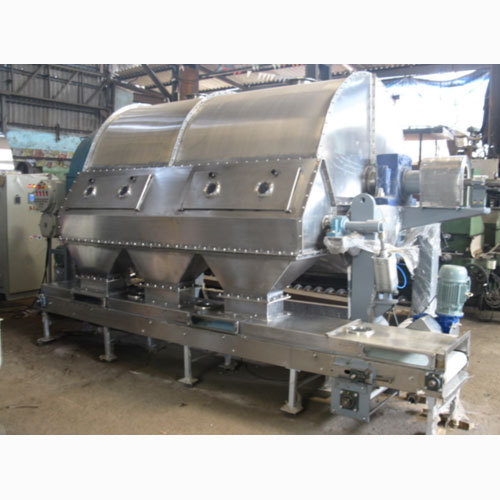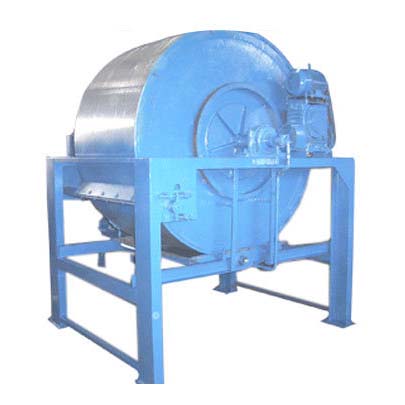Rotary Drum Flaker
We Offer Rotary Flaker, Flaker Machines, Industrial Flaker, Chemical Flaker, Industrial Drum Flaker, Drum Dryer, Double Drum Dryer Manufacturers, Suppliers, Providers, Exporters.
A Rotary Drum Flaker is an essential component of industrial process machinery employed in numerous industries such as the chemical, food, and pharmaceutical industries to transform liquid substances into flaky forms. The drum is a large rotating cylinder normally made of metal and fitted with internal cooling system. This cooling mechanism is very important in the operation since it makes the liquid product applied on the surface of the drum to solidify in a very short time.
Rotary Drum Flaker Design:
The Rotary Drum Flaker is a critical component of the drum flaker machine. It is usually made of materials with good thermal conductivity to ensure effective cooling.
Cooling System:
Cool water is circulated through the interior of the drum or applied externally to maintain a lower temperature during the flaking process.
Operation:
The molten material is fed onto the rotating drum, which is cooled by water.
As the material comes into contact with the cooled drum surface, it solidifies and forms a thin layer.
A scraper or blade removes the solidified material from the drum surface in the form of flakes.
Materials Processed:
Rotary Drum Flaker machines are used for a variety of materials, including chemicals, pharmaceuticals, food products, and certain polymer applications.
Benefits of Rotary Drum Flaking:
Uniform Flake Size: The process typically produces uniform flakes, ensuring consistency in the final product.
Cooling Efficiency: The use of cool water helps in rapid and efficient solidification of the material.
Low Dust Generation: Flake formation in a controlled environment minimizes dust generation.
Easy Handling: The resulting flakes are often easier to handle, transport, and store than the original molten or liquid material
Applications:
Chemical Industry: Drum flakers are used for chemicals such as resins, fatty acids, and certain polymers.
Pharmaceuticals: Common applications include the flaking of pharmaceutical intermediates.
Food Industry: Used for processing food products like fats and oils.
Polymer Industry: Certain polymers are processed using drum flaker machines.
Cooling Water System:
The cooling water system is designed to maintain the desired temperature on the drum surface.
Recirculation systems are often employed to optimize water usage.
Adjustable Parameters:
Some drum flaker machines allow adjustment of parameters such as drum speed and cooling water flow to optimize the flaking process.
Maintenance and Cleaning:
Regular maintenance is essential to ensure the proper functioning of the drum flaker.
Cleaning procedures are implemented to prevent cross-contamination between different materials.
Safety Measures:
•Safety features such as interlocks and emergency stops are incorporated to ensure safe operation.
11.Integration with Downstream Processes:
•Drum flaker machines are often integrated into production lines, and their output may be further processed in subsequent steps.
Using cool water in drum flaker machines is a common and effective method for producing solid flakes from molten or liquid materials. It offers advantages in terms of uniformity, cooling efficiency, and ease of handling in various industries.
Drum flaker machine working principle
The hot material is applied to the cooling drum by direct immersion into a trough, or indirect immersion using doctor/applicator rolls. The molten liquid is cooled on the cooling drum and after a partial revolution; the cooled and solidified product is removed by a scraper in the form of flakes or film. The cooling drum of the flaker is specially designed to provide an even cooling effect by having uniform and effective internal distribution. As a result, both high output and homogeneity of the product are possible.
| Model | Atmospheric and open type |
|---|---|
| Drum dimension | ø400 × 500 L (surface area: 0.625m2) |
| Drum cooling method | Double drum cooling |
| Drum material | SUS304+hard chromium plate |
| Drum rotation speed | 0.2 ~ 15rpm |
| Available type | Any of the dip-feed, side-feed, top roll feed types can be tested. |
The drum flaker transforms a molten product into a solid. The process that takes place is a solidification and/or crystallization process. The product begins to solidify the moment it comes into contact with the cold, rotating drum. After one revolution the completely solidified layer is removed from the drum by a knife and typically breaks into easy to handle Flakers.
The form and size of the Flakers depend on the nature of the product, but also to some extent on the process conditions.
Abster has of specialty machines. The surface can also be furnished with special grooves for products with poor adhesion properties. There are three designs of Drum Flakers Dryer as below:
1. Dip Feed Drum Flakers Dryer
For products with low viscosity and good adhesion properties a drum flaker with dip pan is used. In this type the rotating drum runs continuously through the heated melt in the dip pan underneath the drum.
2. Overhead Applicator Roll Drum Flakers Dryer
For product with moderate to high viscosity, the overhead applicator roll is used. A heated applicator roll is positioned above the cooling drum. The melt can be easily fed via the trough-shaped nip between the applicator roll and the cooling drum. Contact with the hot applicator roll ensures that the product remains liquid.
3. Twin Drum Flakers Dryer
Drum dryers are of conductive heat-transfer type. A heating medium (generally steam) is sent into the rotating drum (cylinder) and liquid material is fed on the heated drum to evaporate and concentrate, and concurrently the liquid material is stuck on the drum surface in the form of a film, then promptly evaporated and dried. Dried materials are scraped continuously with a stationary knife.
Drum dryers are roughly classified into an atmospheric type and vacuum type according to operating pressures, and also, they are classified into a double drum type, twin drum type, and single drum type according to the number of drums.
Further, the single drum type is classified into a dip type, spray type, splash type, top roll type (single-stage, multi-stage), side roll type, below roll type, etc. according to the liquid feeding methods. These classifications are based on the trial for making materials adhere to the drum surface more uniformly and efficiently.
The Drum Flaker enables processing of molten products into excellent quality Flakers. The well-considered concept of the drum flaker has led to a number of features :
- Compact unit, little floor space required;
- Completely closed cooling system, absolutely no cross-contamination between cooling medium and product;
- Low operational and maintenance costs
- Gastight enclosures
- Easy inertisation of the process;
- Unit designed with good access for maintenance and cleaning
- Construction material ranges from carbonsteel to various grades of stainless steel, Hastelloy, etc.
- Operation is continuous, allowing products of stable quality.
- Drying time is short and materials are not exposed to high temperatures for a long period, making materials which are sensitive to heat possible to dry well.
- Drum dryers are devices which are rational in most to perform evaporation and drying at the same time.
- Because the drum dryer is a heat-transfer drying system, its thermal efficiency is better than that of the other type of dryers and it is very economical.
- Because no liquid is left inside at shutdown, processing is possible to the last one drop.
- Performance adjustment is easy to carry out extensively, allowing one person to manage several units.
- Cleaning in the dryer is simple, making a change of application easy.
Types of Flaker Drums and Their Applications
| Type of Flaker Drum | Description | Applications |
|---|---|---|
| Rotary Drum Flaker | Uses a rotating drum with a heated surface to produce flakes from molten or soft materials. | - Chemical Industry: Produces flakes from chemical compounds. - Food Industry: Creates flaked food products. - Pharmaceutical Industry: Flakes pharmaceutical compounds. |
| Cooling Drum Flaker | Features a drum with a cooling system that solidifies material into flakes as it cools down. | - Plastic Industry: Produces plastic flakes from melted plastic. - Chemical Industry: Cools and flakes chemical by-products. |
| Drum Flaker with Scraper | Incorporates a scraper to remove flakes from the drum surface. | - Mineral Processing: Flakes minerals and ores. - Chemical Processing: Processes chemical compounds into flakes. |
| Vertical Flaker Drum | A vertical drum that helps in flaking materials with minimal space. | - Pharmaceutical Industry: Flakes active pharmaceutical ingredients. - Food Industry: Creates flakes from various food ingredients. |
Rotary Drum Flaker Capacity
| Model | Drum specification mm | Motor power KW | Slice speed r/min variable frequency control | Reference external dimensions | ||
|---|---|---|---|---|---|---|
| L | W | H | ||||
| DF400 I | 400x400 | 3 | 2-10 | 1350 | 800 | 1200 |
| DF600 I | 600x600 | 3-4 | 2-10 | 1550 | 1000 | 1400 |
| DF600 II | 600x800 | 3-4 | 2-10 | 1750 | 1000 | 1600 |
| DF800 I | 800x800 | 4-5.5 | 2-10 | 1750 | 1200 | 1800 |
| DF800 II | 800x1000 | 4-5.5 | 2-10 | 1950 | 1200 | 1800 |
| DF1000 I | 1000x1000 | 4-5.5 | 2-10 | 1950 | 1400 | 2000 |
| DF1200 I | 1200x1200 | 5.5-7.5 | 2-10 | 2200 | 1600 | 2200 |
| DF1200 II | 1200x1500 | 5.5-7.5 | 2-10 | 2600 | 1600 | 2200 |
| DF1500 I | 1500x1500 | 5.5-7.5 | 2-10 | 2600 | 1900 | 2400 |
| DF1600 I | 1600x1800 | 7.5-11 | 2-10 | 3000 | 2000 | 2500 |
| DF1800 I | 1800x1800 | 11-15 | 2-10 | 3000 | 2200 | 2600 |
| DF1800 II | 1800x2000 | 11-15 | 2-10 | 4200 | 2100 | 2600 |
| DF2000 I | 2000x2000 | 11-15 | 2-10 | 3700 | 2500 | 2800 |
| DF2000 II | 2000x2500 | 15-18.5 | 2-10 | 3700 | 3000 | 2800 |
| DF2000 III | 2000x3000 | 15-18.5 | 2-10 | 4700 | 2400 | 2800 |





